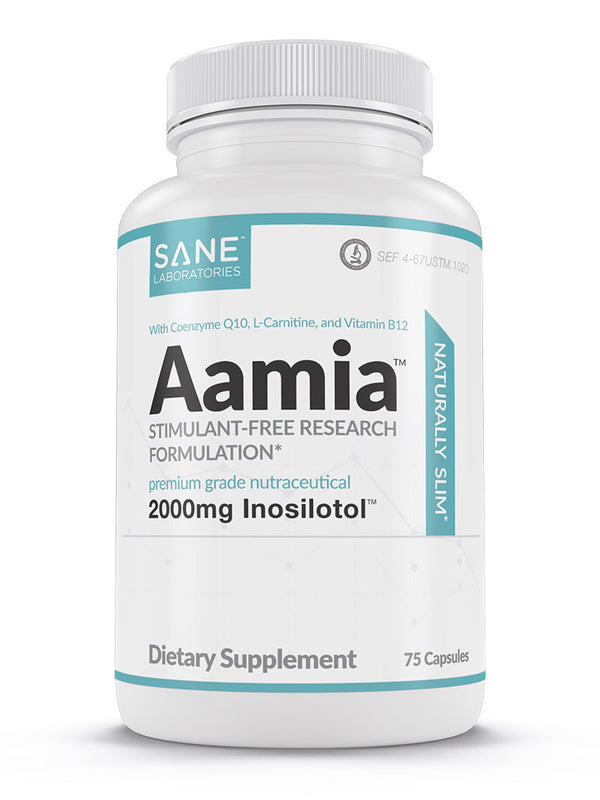Imagine your body giving you a heads-up—like a flashing yellow light, signaling it's time to slow down and make a change. That’s what prediabetes is, essentially. It’s your body's way of letting you know that your blood sugar levels are creeping up, but you're not quite at the type 2 diabetes threshold yet. The good news? You still have a chance to hit the brakes and turn things around.
Click here to learn more about Aamia® and to place your order now while supplies last!
What is Prediabetes?
Prediabetes is when your blood sugar levels sit higher than they should but haven’t reached the point where you’d be diagnosed with diabetes. It’s like walking on the edge of a cliff—you’re not over the edge, but you’re getting close. This condition is becoming more and more common, thanks to changes in our diets and lifestyle habits over the years. When you have prediabetes, your body isn’t handling insulin properly, and glucose starts building up in your bloodstream. Left unchecked, this can lead to serious health problems like heart disease—especially if it progresses to type 2 diabetes.
The Numbers to Watch:
-
Fasting Blood Sugar: 100-125 mg/dL
-
A1C Levels: 5.7-6.4%
If your numbers fall in this range, it’s time to sit up and take notice. But don’t worry—you’re still in the driver’s seat. According to the American Diabetes Association, these numbers are critical indicators for diagnosing prediabetes.
Symptoms to Look Out For:
Here’s the tricky part: prediabetes symptoms often don’t come with any glaring signs. This is why regular checkups are so important. That said, some signs that could hint at prediabetes include:
-
Feeling extra thirsty or making more bathroom trips than usual
-
Fatigue that lingers no matter how much sleep you get
-
Blurred vision that doesn’t seem to clear up
-
Dark patches of skin, especially around your neck or armpits

Risk Factors for Prediabetes: Who’s More Likely to Be at Risk?
Knowing the risk factors for prediabetes can give you a sense of where you or someone you care about might stand. Here’s a breakdown of common risk factors:
-
Family History: If your parent or sibling has type 2 diabetes, your chances go up.
-
Body Weight: Carrying extra weight, particularly around your midsection, increases risk. Achieving and maintaining a healthy body weight can significantly lower blood sugar levels and improve overall health outcomes.
-
Age: While prediabetes can happen at any age, being over 45 puts you more at risk.
-
Lifestyle: A sedentary lifestyle, poor diet choices, or smoking can add to the problem.
-
Pregnancy: Gestational diabetes (which some women develop during pregnancy) can also increase your future risk.
-
Other Health Conditions: Things like high blood pressure, high cholesterol, or polycystic ovary syndrome (PCOS) can be risk factors, too.
Your Game Plan for Taking Control
Here’s the part you’ve been waiting for: the steps you can take to manage—and possibly even reverse—prediabetes. We’ll dive into more details on each strategy in the main article, but here’s a little preview to get you started:
-
Understanding the Setpoint Diet: This isn’t your average diet. It’s designed to rev up your metabolism and keep your blood sugar steady.
-
Smarter Exercise: Believe it or not, exercising smarter (not harder) can help you shed weight more effectively, which is crucial for weight loss and managing prediabetes.
-
Balancing Hormones: Optimizing insulin sensitivity is key, and it goes hand-in-hand with managing hunger hormones.
-
Better Sleep: Quality sleep doesn’t just make you feel refreshed—it can also help cut cravings and boost your metabolism.
Remember, prediabetes isn’t a dead-end. It’s more like a wake-up call—a reminder that you have the power to make choices that can change your health trajectory. Stick around for the full article, where we’ll unpack these natural strategies in greater detail. In the meantime, why not share this with a friend or family member? You never know who might need the same nudge toward better health!
Read on to discover 14 natural strategies to prevent or reverse prediabetes!
Lifestyle Changes to Prevent or Reverse Prediabetes
Preventing or reversing prediabetes isn’t just about eating better or exercising more—it’s about embracing a healthier lifestyle from all angles to lower blood sugar levels. Small but meaningful adjustments can have a big impact on your health, especially when combined with good habits in diet, exercise, and mental wellness.
Here are four lifestyle tweaks you can start making today to help keep prediabetes at bay—or even reverse it.
1. Prioritize Quality Sleep
Good sleep is more than just feeling refreshed when you wake up—it’s also key to keeping your blood sugar and insulin levels in check. Aim for 7-9 hours of restful sleep each night, and try to stick to a consistent bedtime, even on weekends. Create a relaxing pre-bed routine, like cutting down on screen time and skipping heavy meals or caffeine before bed.
When your body is well-rested, your hormones stay balanced, which helps manage blood sugar more effectively.
2. Hydrate with Purpose
Drinking enough water is one of those things we all know we should do, but it’s easy to overlook. Staying well-hydrated helps your body function at its best—and it can even help keep your blood sugar in a healthier range. Try drinking a glass of water before meals to control appetite, and focus on consistent hydration throughout the day to support kidney function, helping to flush out excess glucose.
Tip: Carry a reusable water bottle as a reminder to keep sipping, and opt for water or herbal teas instead of sugary drinks.
3. Create a Stress-Free Environment
Stress has a sneaky way of throwing everything out of balance, including your blood sugar levels. Chronic stress can mess with your hormones, leading to higher blood sugar. To reduce stress, try creating a calming home environment—declutter your space, add some soothing colors or calming scents, and spend time with loved ones.
Finding joy in hobbies and practicing gratitude can shift your focus from stress to the positive things in life.
4. Build Strong Social Connections
Having a support system is priceless when it comes to staying motivated. Whether it’s a local group or an online community, connecting with people who share your health and wellness goals can keep you accountable. You can bond over activities like cooking healthy meals together or going for a walk in nature.
These social connections will boost your emotional well-being, making it easier to stick to your healthy habits and avoid falling back into old routines.
Taking these steps can give you the upper hand when it comes to managing prediabetes. Remember, the path to better health starts with small, simple changes that can lead to lasting results. Share these tips with friends and family to inspire them to take their own steps toward wellness.
Diet Changes to Prevent or Reverse Prediabetes
One of the most powerful tools in managing prediabetes is what you put on your plate. Smart, healthy diet choices can stabilize your blood sugar and give your metabolism the support it needs. By following the principles of the Setpoint Diet, you can make food choices that help prevent or even reverse prediabetes.
Here are five simple but effective diet changes you can start making today:
1. Boost Fiber Intake
Fiber plays a huge role in slowing down how fast your body absorbs sugar, which helps improve insulin sensitivity and lowers blood sugar levels. Plus, fiber helps you stay full longer, making it easier tolose weight and maintain a healthy weight. Try adding more non-starchy veggies like spinach, broccoli, and cauliflower to your meals. Fruits like berries and citrus are great low-fructose options packed with fiber and antioxidants.
Need a crunchy snack? Go for a handful of almonds or walnuts. They’re not only full of healthy fats but also offer a satisfying dose of fiber.
2. Choose Nutrient-Dense Proteins
Protein is key to keeping your blood sugar steady. It helps you feel full and stabilizes insulin levels. Look for nutrient-dense proteins like wild-caught salmon, grass-fed beef, and pastured eggs. If you prefer plant-based options, hemp seeds, chia seeds, and pea protein are great alternatives.
Pair your proteins with non-starchy vegetables for a balanced, blood-sugar-friendly meal.
3. Embrace Whole-Food Fats
Healthy fats are your friend when it comes to reducing insulin resistance and inflammation. Avocados, coconuts, and olives are excellent sources of whole-food fats that can support your blood sugar control. To boost your omega-3 intake, try adding fatty fish like sardines and mackerel to your meals.
By focusing on whole-food fats, you’re nourishing your body while keeping your blood sugar levels stable.
4. Prioritize Probiotic Foods
Your gut health is more connected to your blood sugar than you might think. Probiotic-rich foods like plain Greek yogurt, sauerkraut, and kimchi can help improve gut health and, in turn, help regulate blood sugar. Fermented foods provide beneficial bacteria that aid digestion and keep blood sugar levels in check.
Pairing probiotics with fiber-rich veggies is a winning combination for both your gut and blood sugar.
5. Limit Processed Foods and Sugars
Processed foods are often loaded with hidden sugars and unhealthy fats that can spike blood sugar levels. Skip sugary snacks, sodas, and packaged foods with unpronounceable ingredients. Instead, when you’re craving something sweet, reach for fresh berries or a square of dark chocolate (look for 70% cacao or higher).
Cooking at home with whole ingredients is the best way to make sure you’re fueling your body with what it really needs.
6. Hydrate with Green Tea
Green tea is a powerhouse when it comes to managing blood sugar. It's packed with antioxidants called catechins, which can help improve insulin sensitivity. Swap out sugary drinks for freshly brewed green tea. You can enjoy it hot or cold—try adding a squeeze of lemon or a few mint leaves for a little extra flavor.
Staying hydrated with this antioxidant-packed drink can make a big difference in your blood sugar control.
Making these diet changes can be a game-changer in preventing or reversing prediabetes. Small adjustments to your eating habits can add up to big improvements in your health. Why not share these tips with friends and family and make healthier choices together?
Physical Activity Changes to Prevent or Reverse Prediabetes
Physical activity is one of the most powerful tools you have to manage your blood sugar and improve insulin sensitivity. With a few strategic adjustments to your routine, you can turn exercise into a key weapon against prediabetes.
Here are four simple changes to get you started:
1. Embrace Eccentric (Smarter) Exercise
If you haven’t heard of eccentric exercise, you’re in for a treat—it’s sometimes called "smarter" exercise because it focuses on the lowering phase of movements, like when you squat down or lower a weight. This kind of resistance training can give you maximum benefits in less time. By focusing on eccentric contractions, your muscles keep burning calories long after your workout is over, giving your metabolism a serious boost.
Start with simple moves like eccentric squats, push-ups, and bicep curls to build strength and improve insulin sensitivity, all while spending less time working out.
2. Try High-Intensity Interval Training (HIIT)
HIIT is a favorite for a reason—it alternates between short bursts of intense activity and periods of rest or low-intensity movement. The best part? These sessions are quick but super effective. In just 20 minutes, you can improve your heart health and insulin sensitivity. Think sprints, jumping jacks, or burpees, followed by walking or light jogging.
Adjust the intensity to your fitness level, and you’ll start seeing improvements in your blood sugar control in no time.
3. Make Daily Movement a Priority
We often think of exercise as something we schedule, but don’t forget about the power of everyday movement. Take a quick 5-minute walk every hour, choose the stairs over the elevator, or sneak in a stretch during your favorite show’s commercial breaks. You could even switch to a standing desk or take phone calls while walking around.
These little movements throughout the day help keep insulin resistance at bay and prevent long periods of inactivity, which can negatively affect your blood sugar.
4. Engage in Functional Fitness
Functional fitness is all about exercises that mimic everyday movements—things like lunges, farmer’s carries, or twisting motions that build strength and stability for daily life. These exercises improve balance, flexibility, and coordination while toning your muscles.
Not only does functional fitness make day-to-day tasks easier, but it also helps your body regulate blood sugar more effectively. It’s a win-win!
By making these physical activity changes, you’ll be taking control of your health and tackling prediabetes head-on. Remember, these small tweaks can add up to big benefits over time.
Frequently Asked Questions About Prediabetes
When it comes to prediabetes, it’s natural to have a lot of questions. Whether you’re managing the condition yourself or looking out for a loved one, getting clear, helpful answers can make all the difference.
Below are some of the most frequently asked questions about prediabetes, along with simple explanations to guide you.
1. What exactly is prediabetes, and how is it different from diabetes?
Prediabetes is like an early warning system for your body. It means your blood sugar levels are higher than normal but not quite high enough to be classified as type 2 diabetes. Think of it as being on the edge—you’re not over the line yet, but you’re close enough that you need to take action to prevent it from progressing to full-blown diabetes.
2. Can prediabetes be reversed, or is it permanent?
Yes, prediabetes can absolutely be reversed! The key is making healthy lifestyle changes—like improving your diet, getting regular exercise, and managing stress. By taking action early, many people are able to bring their blood sugar levels back to a normal range and avoid developing diabetes altogether.
3. What symptoms should I look out for if I think I might have prediabetes?
One of the tricky things about prediabetes is that it often doesn’t come with obvious symptoms. That’s why many people don’t know they have it until they get their blood sugar checked. However, some possible signs to watch for include feeling extra thirsty, going to the bathroom more often, feeling unusually tired, or noticing dark patches of skin on areas like your neck or armpits.
4. Who is most at risk for developing prediabetes?
Certain factors can increase your chances of developing prediabetes. These include having a family history of type 2 diabetes, being overweight (especially around your belly), being over the age of 45, leading a mostly sedentary lifestyle, or having high blood pressure or cholesterol. If any of these sound familiar, it might be a good idea to talk to your doctor about getting tested.
5. What should I eat if I have prediabetes?
The goal is to choose foods that help stabilize your blood sugar and keep your insulin levels in check. Focus on eating plenty of non-starchy vegetables (like leafy greens and broccoli), lean proteins (such as fish or chicken), healthy fats (like avocados and olive oil), and whole grains in moderation. Avoiding processed foods and sugary snacks is also key to managing prediabetes.
By getting informed and making smart lifestyle choices, prediabetes doesn’t have to turn into diabetes. If you have more questions, don’t hesitate to talk to a healthcare professional—they can provide personalized guidance based on your situation.
Take Control and Share the Journey
Managing prediabetes doesn’t have to feel overwhelming. From adjusting your diet to making exercise a regular part of your life, you’re setting yourself up for success. Share this article with friends and family to inspire them to join you on this path to better health. Together, you can build a supportive community that thrives on smart choices and positive change!
Take Control of Your Blood Sugar Naturally with Aamia®!
Managing prediabetes doesn’t have to be overwhelming. Aamia® contains natural ingredients, including chromium, which has been clinically shown to help regulate blood glucose levels. By supporting your body’s natural balance, Aamia® empowers you to take proactive steps toward healthier blood sugar levels and overall well-being.
Ready to take the next step?
Click here to learn more about Aamia® and to place your order now while supplies last!
































